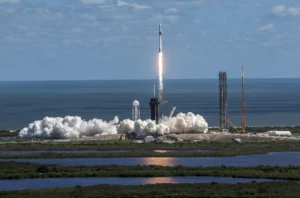Key Takeaways from NASA and Elon Musk’s November Meeting
● SpaceX pitches MarsLink to NASA: a Mars version of Starlink for high-speed communication.
● The system will deploy multiple satellites in Mars orbit for continuous, high-speed connectivity.
● NASA has demonstrated data downlink via laser communication.
● MarsLink is designed to support future Mars missions and long-term human colonisation.
● Starlink, SpaceX’s global internet network, provides the foundation for the MarsLink concept.

Table of Contents
In-Depth Report
On November 7, 2024, SpaceX and NASA officials, as part of the Mars Exploration Program Analysis Group (MEPAG), convened to discuss an innovative communications proposal: MarsLink. This system, conceived by SpaceX, would build on the company’s Starlink network to establish high-speed, reliable internet connectivity specifically for Mars missions.
MarsLink aims to provide data rates exceeding 4 Mbps, introducing new capabilities such as real-time imaging and monitoring of the Martian surface, marking a significant leap in future space exploration.

Starlink’s Blueprint for MarsLink
Starlink, SpaceX’s satellite-based broadband service, has already made waves in global internet connectivity. It provides high-speed access to remote and underserved regions. With a network of low-Earth orbit (LEO) satellites, Starlink is known for its low latency and high throughput. SpaceX plans to leverage this expertise in the Martian environment to create MarsLink, which would rely on satellites orbiting Mars rather than Earth. These satellites would form a communications network capable of providing continuous data transmission to astronauts, rovers, and mission control on Earth.
Read this also: SpaceX Achieves Major Milestone with Successful Starship Flight 5 Launch and Booster Recovery
NASA’s Progress with Laser Communication
In related developments, NASA has made significant strides in demonstrating the viability of high-speed communications across vast distances. A recent test showed that a spacecraft, 240 million kilometres away (the farthest point Mars can reach from Earth), successfully achieved over 6 Mbps downlink using laser communication technology.
This breakthrough lays the groundwork for systems like MarsLink, which could also rely on similar laser-based communication to ensure high-bandwidth, low-latency connections, even in the harsh Martian environment.

Addressing the Challenges of Martian Communication
One of the main challenges discussed during the meeting was the communication difficulties posed by Mars’s thin atmosphere, extreme temperatures, and frequent dust storms. These conditions could disrupt signals and data transmission.
However, SpaceX’s plan for MarsLink includes deploying multiple satellites in orbit around Mars to ensure uninterrupted coverage, helping to mitigate these environmental hurdles. This satellite constellation would also provide robust data relay capabilities, enhancing mission safety and operational efficiency.
Read this also: TuTr Hyperloop: The IIT Madras Startup Driving India’s Hyperloop Revolution
NASA’s Growing Interest in Commercial Solutions
During the meeting, NASA expressed strong interest in MarsLink and acknowledged its potential to support both upcoming Mars missions and the long-term objectives of human colonisation. According to reports from SpaceFlight Now, NASA is increasingly exploring partnerships with private aerospace companies, including SpaceX, to fulfil its Mars exploration needs.
One such collaboration could see NASA contracting commercial services like MarsLink to provide critical communication support for astronauts and rovers, enabling real-time data transfer and video feeds, as well as aiding in scientific experiments.

The Bigger Picture
Building on NASA’s success with laser communication technology, MarsLink could provide the infrastructure needed for future Mars missions. This system could offer the kind of connectivity required for astronauts to stay in constant communication with Earth, ensuring their safety and enabling greater scientific discovery.
As SpaceX continues to push forward with its vision, the possibility of a fully connected Mars—one where real-time communication with Earth is the norm—becomes increasingly realistic. In the coming years, MarsLink could become a cornerstone of humanity’s effort to establish a permanent presence on the Red Planet.








